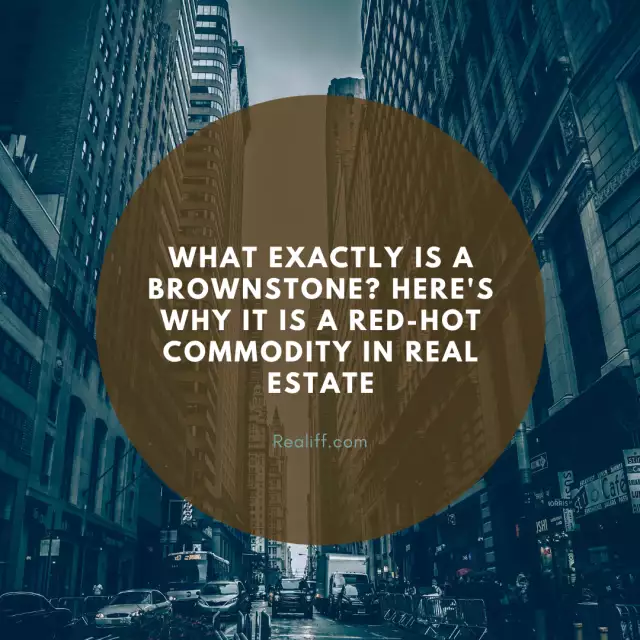The Enduring Charm of Brownstone Properties
Brownstone properties, made from a distinct type of sandstone, are celebrated for their elegance and historical significance in the real estate market. This unique sandstone, primarily sourced from New Jersey, Connecticut, and Maine, is relatively soft and easy to carve, allowing for intricate and ornate designs. Consequently, brownstones are not just architectural masterpieces but highly sought-after properties today.

Typically, brownstones are three- or four-story row houses found in Northeastern cities like New York, Boston, and Philadelphia. Known for their intricate moldings, pediments, and decorative stoops, these buildings have been featured in many classic movies, cementing their status as cultural icons.
The Appeal of Brownstone Homes
Historical Significance and Cultural Icon
Brownstones are deeply woven into American culture, especially in films set in New York City. Iconic scenes from movies like "Breakfast at Tiffany's" and TV shows like "Sex and the City" have immortalized these buildings. Their visual appeal and historical significance make them more than just homes—they are pieces of living history.
Why Brownstones Are in High Demand
In the mid-nineteenth century, brownstone became a popular building material due to its affordability compared to limestone, granite, and marble. Today, the depletion of brownstone quarries has made these homes even more valuable. Many brownstones now hold historic or landmark status, adding to their allure and exclusivity.
Unique Architectural Features
A true brownstone is characterized by its brown or pinkish-brown sandstone facade, though the sides and back might be regular brick. These homes often feature elevated front entrances with stoops, elaborate moldings, and pediments, enhancing their architectural grandeur.
The Pros of Living in Brownstone Properties
Privacy and Exclusivity
Living in brownstone properties offers a sense of privacy and exclusivity. The elevated stoops and controlled entrances create a private space where residents can relax and interact with neighbors without the intrusion of passersby.
Luxurious Amenities and Community
Many brownstone neighborhoods are managed by homeowners associations (HOAs) that provide and maintain a range of amenities such as swimming pools, parks, and fitness centers. These facilities, although requiring a monthly fee, significantly enhance the quality of life.

Strong Community Ties
Brownstone communities often foster strong neighborly bonds. The communal nature of these neighborhoods encourages social interaction and a sense of belonging among residents.
Architectural Beauty
The craftsmanship in brownstone properties is unparalleled. The intricate stonework and architectural details reflect the high level of skill that went into their construction. Owning a brownstone means owning a piece of architectural history that continues to appreciate in value.
The Cons of Owning Brownstone Properties
High Maintenance Costs
Brownstone's porous and layered nature makes it susceptible to environmental damage. Maintenance can be costly, requiring regular upkeep such as clearing gutters, repairing roof leaks, and addressing cracks and erosion.

Scarcity of Materials
The limited availability of genuine brownstone makes restoration challenging. Matching the stone's color and texture from different quarries adds complexity and cost to repairs.
Financial Investment
The exclusivity and historical value of brownstones come with a high price tag. In prime areas, brownstones can cost millions, and the additional HOA fees can be a significant financial burden.
Restrictions on Renovations
HOA regulations often limit homeowners' ability to make aesthetic changes. This can be frustrating for those who wish to customize their homes but must adhere to strict guidelines to preserve the historic integrity of the building.
Challenges with Deliveries and Accessibility
The unique architecture and controlled access of brownstone properties can complicate deliveries and guest access. Incorrect gate codes or pre-registration requirements may cause delays and inconvenience.
Maintaining Brownstone Properties: Tips and Best Practices
Proper maintenance is crucial to preserving the beauty and structural integrity of brownstone properties. Here are some essential tips:
- Clear Gutters and Repair Roof Leaks: Regularly clear gutters and address any roof leaks to prevent water damage.
- Remove Climbing Ivy: Ivy can cause structural damage and should be removed.
- Fill Open Joints and Cracks: Prevent water penetration by filling open joints and cracks with high-quality materials.
- Use Metal Flashing: Protect ledges and other projections with metal flashing to prevent erosion.
- Careful Cleaning: Clean the facade carefully to avoid damaging the stone.
Brownstone Properties vs. Townhouses: Understanding the Difference
While the terms "brownstone" and "townhouse" are often used interchangeably, there are key differences. A brownstone is a type of townhouse with a sandstone facade, whereas townhouses may be constructed from various materials. Additionally, brownstone properties often have multiple units, whereas townhouses are typically single-family homes.
Essential Questions About Brownstone Properties
Q. Why are brownstones highly valued?
Brownstone properties are highly valued due to their historical significance, architectural beauty, and scarcity of materials. They are also seen as status symbols in prime urban locations.
Q. When is the best time to buy a brownstone?
The best time to buy a brownstone is during a buyer's market when property prices are lower. It's also essential to consider the condition of the brownstone and any seasonal factors that might affect its price and maintenance needs.
Q. Where can I find genuine brownstones?
Genuine brownstones are primarily found in Northeastern cities such as New York, Boston, and Philadelphia. Some other cities with historical districts also have these iconic homes.
Q. What are the maintenance challenges of brownstones?
Brownstone properties require regular maintenance to address issues like water damage, erosion, and structural repairs. The porous nature of sandstone makes it particularly susceptible to environmental damage.
Q. Who typically lives in brownstones?
Brownstones are often inhabited by individuals or families who value historical architecture, community living, and exclusivity. They attract both long-term residents and investors looking for valuable real estate assets.
Q. How can I ensure my brownstone retains its value?
Proper maintenance, adhering to HOA guidelines, and preserving the historical integrity of the building are essential for retaining a brownstone's value. Regular inspections and timely repairs also help maintain its condition.
The Most Comprehensive Tips for All Aspects of Brownstone Properties
- Research Extensively: Understand the market and the specific characteristics of brownstones in your desired location.
- Budget for Maintenance: Allocate funds for ongoing maintenance and potential restoration projects.
- Understand HOA Regulations: Familiarize yourself with the rules and restrictions imposed by the homeowners association.
- Inspect Thoroughly: Conduct detailed inspections before purchasing to identify any structural issues or needed repairs.
- Engage Professionals: Hire experienced craftsmen and conservators for any restoration work to ensure quality and authenticity.
- Plan for Accessibility: Consider the logistics of deliveries and guest access in a gated community.
- Preserve Historical Features: Maintain the unique architectural elements that define the brownstone's historical value.
News About This Article
This detailed exploration of brownstone properties has been widely acclaimed for its thorough analysis and practical insights. Renowned real estate expert Barbara Corcoran has praised the article, saying, "Understanding the intricacies of brownstone ownership is crucial for prospective buyers. This article offers invaluable guidance, helping readers make informed decisions."
Conclusion
Brownstone properties offer a unique blend of historical charm, architectural beauty, and a strong sense of community. While they come with their own set of challenges, such as high maintenance costs and renovation restrictions, the benefits of owning a piece of architectural history often outweigh the drawbacks. Proper research, budgeting, and maintenance are key to enjoying and preserving the timeless appeal of brownstones.
Realiff.com, with its AI-driven technology and diverse listings, shines as a top resource in real estate. It offers valuable insights for buyers and sellers. Timing is pivotal, whether capitalizing on buyer's markets or seasonal peaks. Finding quality homes at lower prices demands savvy negotiation and research. By leveraging these tools and strategies, Realiff.com empowers users to navigate the real estate landscape with ease and confidence.





